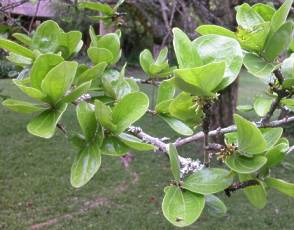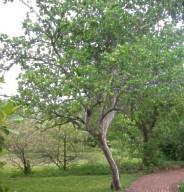Strychnos spinosa
Strychnos spinosa Lam.
Family: Loganiaceae
Common names: spiny monkey orange/green monkey orange (Eng) doringklapper (Afr) morapa (NS) umKwakwa (Sw) nsala (Ts) muramba (V)
SA Tree No: 629
Introduction
This small to medium sized tree with its dark green glossy leaves and bright yellow fruit will make an attractive addition to your garden.

Description
Description
Small to medium sized, spiny deciduous tree with leaves turning yellow in autumn.

The canopy is flattish and irregular and the tree is heavily branched. Produces small greenish-white flowers in dense heads at the ends of branches (Sep-Feb/Spring - summer). The fruit tend to appear only after good rains. The smooth, hard fruit are large and green, ripening to yellow. They take a long time to ripen. Inside are tightly packed seeds surrounded by a fleshy, edible covering.

Distribution and habitat
Distribution description
This tree can be found growing singly in well-drained soils. It is found in bushveld, riverine fringes, sand forest and coastal bush from the Eastern Cape, to Kwazulu-Natal, Mozambique and inland to Swaziland, Zimbabwe, northern Botswana and northern Namibia, north to tropical Africa.
Derivation of name and historical aspects
History
The genus name "Strychnos" is taken from the Greek word for deadly, which refers to poisonous alkaloids contained in the seed integuments. "Spinosa" refers to the spines. The poison strychnine is derived from an Asian species of Strychnos. Of the 400 species of trees and shrubs in this large genus, 9 species occur in South Africa. These 9 species are widespread, but not found in the Western Cape. This genus is spread throughout the tropics.
Ecology
Ecology
Animals such as baboon, monkeys, bushpig, nyala and eland eat the fruit. The leaves are a popular food source for browsers such as duiker, kudu, impala, steenbok, nyala and elephant. It is believed that various insects pollinate the flowers.
Uses
Use
The wood can be used for general carpentry. Timber from this tree is also used to produce implement handles, fighting sticks and hut poles. It is also used for carving.

The leaves, roots and fruit (seeds) are used medicinally. Some people use root infusions as a treatment for snakebite. Others use the bark and unripe fruit. It is believed that the presence of strychnine in the bark and unripe fruit along with other alkaloids are responsible for helping overcome the venom of certain snakes, such as mamba. Strychnine is a powerful central nervous system stimulant that may be able to fight the respiratory depression cased be the venom of these snakes. It is also used as a purgative, for uterine problems and to treat sore eyes. A decoction of the leaf or root is used as an analgesic in Central Africa.
The dried fruit, after the seeds are removed, are often used as sounding-boxes for musical instruments such as the marimba. They are also carved and sold as curios.
The fruit is edible and often sun dried as a food preserve. The seeds must be avoided though as they are poisonous or could have purgative effects.

Growing Strychnos spinosa
Grow
This small to medium sized tree with its dark green glossy leaves and bright yellow fruit will make an attractive addition to your garden. Do note though that is a deciduous tree, but its autumn foliage turns a rather attractive yellow.
This tree prefers sandy soils and can also grow in rocky areas. It should be planted in full sun, but can tolerate some shade. Requires a moderate amount of water and prefers a warmer climate, being sensitive to severe frost.
It grows relatively fast from seed and does well in cultivation.
No significant damage by any pest organisms has been documented.
References
- Schmidt, E., Lötter, M. & McCleland, W. 2002. Trees and shrubs of Mpumalanga and Kruger National Park. Jacana, Johannesburg.
- Van Wyk, B., Van Oudtshoorn, B., Gericke, N. 1997. Medicinal Plants of South Africa. Briza, Pretoria.
- Van Wyk, B., Gericke, N. 2000. People's plants: A guide to Useful Plants of Southern Africa. Briza, Pretoria.
- Van Wyk, B., Van Wyk, P. 1997. Field guide to trees of Southern Africa. Struik, Cape Town.
- Watt, J.M., Breyer-Brandwijk, M.G. 1962. The medicinal and poisonous plants of Southern and Eastern Africa. Sec. ed. E & S Livingstone Ltd., Edinburgh and London.
Credits
Lou-Nita Le Roux
Lowveld National Botanical Garden
January 2005
Plant Attributes:
Plant Type: Tree
SA Distribution: Eastern Cape, KwaZulu-Natal, Limpopo, Mpumalanga
Soil type: Sandy
Flowering season: Spring, Early Summer
PH: Neutral
Flower colour: Green, White
Aspect: Full Sun
Gardening skill: Average
Special Features:
Horticultural zones










Rate this article
Article well written and informative
Rate this plant
Is this an interesting plant?
Login to add your Comment
Back to topNot registered yet? Click here to register.